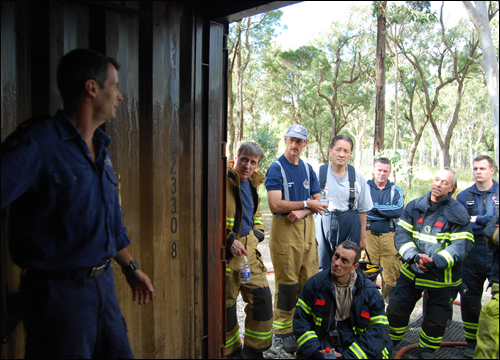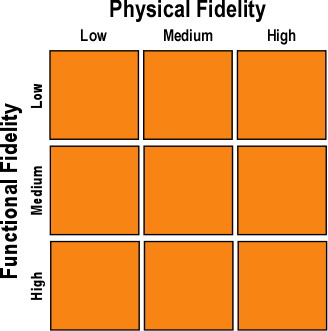Training Fires and “Real” Fires
The theme for the 2009 meeting Institution of Fire Engineers (IFE) Compartment Firefighting Special Interest Group (SIG) in Sydney, Australia was Finding the Common Ground. The 15 participants represented 12 fire service organizations from Australia, New Zealand, Sweden, the UK, Spain, Croatia, China, Canada, and the United States.
Figure 1. 2009 IFE Compartment Firefighting SIG Participants

Understanding & Application
The dominant common theme identified by the participants is the need for firefighters and fire officers to have a solid understanding of fire dynamics and the ability to apply that knowledge in an operational context. Achieving this goal cannot be accomplished simply by delivering a course or training program, it requires a fundamental shift in perspective and ongoing effort to support individual and organizational learning.
Simply achieving knowledge of fire dynamics and skill in task and tactical activity is necessary but not sufficient. Achieving increased safety and effectiveness requires that firefighters and fire officers effectively apply this knowledge on the fireground. Facilitating this transfer from training to operational context is a challenge is a significant challenge.
Dr. Stefan Svensson of the Swedish Civil Contingencies Agency posed the question: How do we get learners to understand the differences between training fires and “real fires”. This is an interesting question in that training conducted in a container, burn building, or acquired structure is in fact a “real fire”, but has considerably different characteristics than a fire occurring in a house, apartment, or commercial building. Improperly designed training may provide the learner with an inaccurate perspective on the fire environment which can lead to disastrous consequences. The challenge is managing risk while developing a realistic understanding of fire behavior.
What is the Difference?
Compartment fires in the training environment differ from those encountered during emergency operations differ on the basis of compartment characteristics, fuel, ventilation profile, heat release rate, and time scale. In addition to differences related to fire dynamics, firefighters and fire officers also encounter psychological stress resulting from a sense of urgency, organizational and community expectations (particularly in situations where persons are reported to be trapped in the building).
Other than acquired buildings, structures used for fire training are generally designed and built for repetitive use and not for regular human habitation. Structural characteristics that make a durable live fire training facility are considerably different than most if not all other structures in the built environment. Density, thermal conductivity, and specific heat of training structures can be considerably different than a dwelling or commercial structure, which has a significant impact on fire behavior.
The ventilation profile of a purpose built prop or burn building is also likely to have significantly different compartmentation and ventilation profile than a typical residential or commercial structure. Live fire training facilities often (but not always) are designed with burn compartments. This speeds fire development and minimizes both initial and ongoing cost. However, fire behavior and the impact of fire control tactics can be considerably different in a large area and/or high ceiling compartment. Many modern structures are designed with open floor plans that are challenging to duplicate in the training environment. Energy efficient structures limit ventilation (air exchange), while training structures are often quite leaky, particularly after extensive use. This can have a significant influence on development of a ventilation controlled burning regime and influence of ventilation on the concentration of gas phase fuel in smoke. Failure of glass windows in ordinary structures should be anticipated, as this changes the ventilation profile and resulting fire behavior. Training structures on the other hand provide a more consistent ventilation profile as durable (e.g., metal) windows do not present the same potential for failure.
While structural characteristics, compartmentation, and ventilation differ between typical structures in the built environment and those used for live fire training, one of the most significant differences lies in the types, quantity, and configuration of fuel.
National Fire Protection Association (NFPA) 1403 Standard on Live Fire Training is fairly explicit regarding fuel characteristics and loading for live fire training evolutions. Most of these provisions can be tied directly to incidents in which participants in live fire training exercises lost their lives. Unfortunately, there are not the same provisions in fire and building codes. Fuel load is considerably higher in most residential and commercial occupancies than is typically used in live fire training, even in advanced tactical evolutions.
Together these differences provide considerably different fire dynamics between the training and operational environments. How much and in what ways does this impact on the effectiveness of compartment fire behavior training (CFBT)?
Fidelity
As discussed, CFBT, even when conducted in an acquired structure does not completely replicate fire conditions encountered in an operational context. All CFBT involves simulation. The extent to which a simulation reflects reality is referred to as fidelity:
The degree to which a model or simulation reproduces the state and behavior of a real world object or the perception of a real world object, feature, condition, or chosen standard in a measurable or perceivable manner; a measure of the realism of a model or simulation; faithfulness… 2. The methods, metrics, and descriptions of models or simulations used to compare those models or simulations to their real world referents or to other simulations in such terms as accuracy, scope, resolution, level of detail, level of abstraction and repeatability. (Northam, n.d.)
CFBT can involve a wide range of simulations, from the use of photos and video, non-fire exercises, small scale props such as doll’s houses, single and multi-compartment props, and burn buildings, and acquired structures. Each provides differing degrees of fidelity.
Fidelity can be described in a number of different ways. One fairly simple approach is to examine physical and functional fidelity (see Figure 2). Physical fidelity is the extent to which the simulation looks and feels real. Functional fidelity is based on the extent to which the simulation works and reacts realistically.
Figure 2. Two-Dimensional Fidelity Matrix

Note: Adapted from Fidelity Versus Cost and its Effect on Modeling & Simulation (Duncan, 2007)
While describing fidelity of a simulation as low, moderate, or high, this is likely to be inadequate. A more useful description of fidelity includes both qualitative and quantitative measures on multiple dimensions. But what measures and what dimension? In a compartment firefighting simulation, key elements of physical fidelity will likely include fire behavior indicators such as Building, Smoke, Air Track, Heat, and Flame (B-SAHF). Important aspects of physical fidelity would include the characteristics of doors and windows (e.g., opening mechanism), hose and nozzles, and influence of tactics such as gas and surface cooling on fire behavior.
On the surface it makes sense that increased fidelity would result in increased effectiveness and transfer of knowledge and skill. However, it is important to remember that “All models are wrong, but some models are useful” (Box & Draper, 1987, p. 424). The importance the various aspects of fidelity depend on the intended learning outcome of the simulation. In fact, a simulation that focuses on critical contextual elements may be more effective than one that more fully replicates reality.
Figure 3. Door Entry Drill

For example, teaching the mechanics and sequence of door entry procedures (see Figure 3) might be more effectively accomplished using a standard door without smoke and flame than under more realistic live fire conditions. On the other hand, reading fire behavior indicators at the door and effectively predicting interior conditions is likely to require substantively different elements of context. However, at this point, we simply have unsupported opinion and in some cases anecdotal evidence of the effectiveness or lack of effectiveness of current training practices. The key to this puzzle is to clearly define the intended learning outcomes and identify the critical elements of context that are required.
Questions Remain
The IFE Compartment Firefighting SIG identified the need for a greater emphasis on fire behavior training at all levels (e.g., entry level firefighters, incumbent firefighters, and fire officer) as well as ongoing professional development and skills maintenance. However, a number of interesting questions remain, including:
- What are the most effective methods of developing firefighters understanding of compartment fire behavior?
- What is necessary to effectively facilitate transfer of this knowledge from training to the operational context?
- What level of fidelity is necessary in live fire training do develop and maintain critical skills?
- How can technological simulation (computer or video based) simulation be used to augment live fire training to maintain proficiency?
- To what extent might non-live fire simulation (e.g., CFBT for the Wii) be used to develop compartment firefighting competencies?
Professor David Morgan of Portland State University observes that “A successful research project requires two things: Meaningful research questions and appropriate means to answer those questions” (Morgan, 2005, p. 1-2). One of the greatest potential benefits resulting from collaboration between members of the IFE Compartment Firefighting SIG is the integration of the skills of academics and practitioners, scientists and firefighters. During the 2009 workshop, SIG member Steve Kerber from Underwriters Laboratory (formerly with the National Institute for Standards and Technology) emphasized the importance of scientists and engineers doing research with, not simply for the fire service. This has the potential to not only identify meaningful questions, but also to provide the knowledge and skills necessary to answer them.
Ed Hartin, MS, EFO, MIFireE, CFO
References
Northam, G. (n.d.). Simulation fidelity – Getting in touch with reality. Retrieved May 2, 2009 from http://www.siaa.asn.au/get/2395365095.pdf
Box, G. & Draper, N. (1987). Empirical model-building and response surfaces. San Francisco: Wiley.
Duncan, J. (2007). Fidelity versus cost and its effect on modeling & simulation. Paper presented at Twelfth International Command and Control Research and Technology Symposium (12th ICCRTS), 19-21 June 2007, Newport, RI.
Morgan, D. (2005). Introduction [to integrated methods] (Unpublished Manuscript). Portland, OR: Portland State University.
Tags: fire behavior, Fire Behavior Training, live fire training, simulation



May 7th, 2009 at 15:00
hello,
thanks for this interesting article.it explains very well that when you “fight “fires in compartment,that is really different from a fire that you have to fight in house or building.
compartment fires are useful for training but you can not say that you “know” the fire and fire dynamics if you do not fight fires in “real” life:houses,warehouses,buildings…..
training is great and can help you at firescene.
best regards.
May 14th, 2009 at 07:07
Laurence, You are correct that there are significant differences between live fire training (as a simulation of the real world) and the fires encountered in the rest of the built environment. However, as I use the term “compartment” fire, this is any fire inside an enclosure (both in the training and operational context).
May 15th, 2009 at 03:02
hello Ed,
thanks for your explanation.
as you probably noticed (in reading my replies),i’m not firefighter but my relatives are here:in France.
i’m really interested in firefighting and i think to bee a “good” firefighter,you need training and experience at fireground.
best regards.
July 7th, 2009 at 06:58
[…] Fire Training: Important Questions In several recent posts (Training Fires and “Real” Fires and Live Fire Training in Purpose Built Structures, I emphasized that all live fire training is a […]
July 16th, 2009 at 10:30
[…] Fire Simulations: Key Elements of Fidelity Several earlier posts (Training Fires Versus Real Fires, Live Fire Training: Important Questions) introduced the concepts of live fire training as […]